October 16, 2018 — "First Man" is a movie steeped in even more space history than audiences might be aware.
The new movie from director Damien Chazelle starring Ryan Gosling as Neil Armstrong, the first man to walk on the moon, is rich in visual and thematic nods to NASA's real history, from the detailed recreations of spacecraft and spacesuits to the use of the actual space-to-ground transcripts that informed the screenplay by Josh Singer.
"I wanted the movie to be tactile, and documentary-like, and realistic, so it felt like we had to have the reality to back up that style," Chazelle said in an interview with collectSPACE.
But in addition to ensuring an overall authenticity for the big set pieces and scenes, Chazelle and his fellow filmmakers also inserted some much more subtle references to the history they were depicting. "First Man" is flush with these hidden details, or "easter eggs," that maybe only eagle-eye space geeks might notice.
For everyone else, here are some of the "small steps" that Chazelle and crew took to infuse "First Man" with even more space history.
Spoiler warning: This article references both minor and major details from "First Man." If you have yet to see the movie, you may want to read it after doing so.
Voices from the past
"Roger, Twan— Tranquility, we copy you on the ground. You got a bunch of guys about to turn blue. We're breathing again. Thanks a lot."
If that line (complete with the initial stumble over the pronunciation of "Tranquility") from "First Man" sounds familiar, it is because it is the exact words radioed to the real Armstrong and Buzz Aldrin after they landed on the moon on July 20, 1969. In fact, it should sound more than just familiar.
"First Man" has actors portraying a number of Armstrong's fellow astronauts, including some who served in Mission Control as the capsule communicator, the crew's point of contact with the ground. But for those they did not cast, including Bill Anders and Bruce McCandless, the filmmakers decided to use the astronauts' real voices from archival audio instead.
So that is the actual Charlie Duke, who served as "CapCom" during the Apollo 11 lunar landing, that audiences hear when Mission Control radios, "We copy you down, Eagle."
It is also Duke who reminds Armstrong (Gosling) about the total amount of fuel he has available before starting the descent to the moon's surface. But unlike the other calls, the audio is not from NASA's archives.
Realizing they needed to explain to moviegoers what was about to transpire on screen — explanations that were absent from the Apollo 11 record — the filmmakers had Duke record a few lines, resuming his role as capcom almost 50 years after the mission.
So the Mission Control that audiences hear during the "First Man" moon landing is consistently Duke, only sometimes his voice is separated by half a century.
Faces in the crowd
Duke's voice is not the only cameo in "First Man." The movie is peppered with faces from the space history community — especially in its depiction of Gemini Mission Control.
When Armstrong (Gosling) and Dave Scott (Christopher Abbott) come back into radio contact after their Gemini 8 spacecraft spins out of control, NASA's director of flight crew operations Deke Slayton (Kyle Chandler) order Paul Haney, the "Voice of Mission Control," to cut off the "squawk boxes" that fed mission audio into the astronauts' homes.
Haney is portrayed (and voiced over the box) by Mark Armstrong, Neil's son. Rick Armstrong, Mark's brother, is also in Mission Control, seated to Mark's right.
Andrew Armstrong, Mark's son, also makes a cameo as the flight controller who is playing guitar after Gemini 8 achieves the world's first docking in space.
Others in Mission Control include Mark Kirkman, a former space shuttle training instructor, who portrays Flight Dynamics Officer (FIDO) Jerry Bostick, and Rick Houston, the co-author of "Go, Flight!: The Unsung Heroes of Mission Control, 1965 1992," who served as a consultant on the Mission Control scenes in "First Man."
The cameos, though, do not end in Mission Control.
At the White House reception, Chazelle's parents are among the guests and his sister, Anna, is the staffer who lets Armstrong know that Slayton is on the phone.
At the Cape, as the Apollo 11 crew is having their pre-launch breakfast, an artist is shown sketching Armstrong. In real life, the late Paul Calle was there to sketch both the breakfast and the astronauts' suiting up as part of NASA's art program. In "First Man," Chris Calle, Paul's son and an accomplished space artist in his own right, portrays his father.
And as Armstrong (Gosling), Aldrin (Corey Stoll) and Michael Collins (Lukas Haas) exit crew quarters to board a van for the launch pad, the three walk down a ramp and pass by a suited gentleman. That onlooker is Kurt Debus, the first director of Kennedy Space Center, as portrayed in "First Man" by historian James Hansen, author of Neil Armstrong's authorized biography, which was the basis for the film.
In that same scene, Bonnie Baer, daughter of Gemini 4 and Apollo 1 astronaut Ed White, also makes a cameo appearance.
Brown bagging it
As Collins (Haas) walks past Debus (Hansen), he is seen carrying a brown paper bag, reproducing a subtle detail from Apollo 11 history.
It was a tradition for the astronauts to bring to the launch pad gag gifts for Pad Leader Guenter Wendt (portrayed by Steve Coulter in "First Man"), who oversaw the crew being strapped into the spacecraft and the final preparations for launch. Armstrong gifted Wendt a coupon for a free ride "between any planet, moon, star or galaxy in the solar system," Aldrin presented a copy of "Good News for Modern Man," a condensed version of the Bible, and Collins pulled out of a brown paper bag a fish mounted to a wooden plaque.
"'At your house, I've never seen a big trophy trout or trophy fish on your wall. You need one,' Collins said, as recalled by Wendt in a 1999 NASA interview. But there were a few things with Collins' fish, hence the gag. It was too small to have been legally caught, it was not cleaned and it was not preserved.
In preparing to portray Collins in "First Man," Haas learned about the trophy fish and realized there was something missing when it came time to film.
"When we were on our way out, walking down the ramp, I didn't have the bag," recalled Haas in an interview with collectSPACE. "And the prop people were like, 'What? No one told us about this.' And I'm like, 'Well if you read Collins' book or look at the [July 16, 1969] picture, you can see he's got a brown paper bag.' So they rushed off and found a brown paper bag."
"I felt proud of the fact that I remembered he needed his fish," said Haas.
The brown bag adds one more authentic detail to a scene that was already more than a mere recreation. The building that Haas, Gosling and Stoll exit and the rampway that they descend are not on a movie set, but were filmed on location at the Kennedy Space Center in Florida.
"That's not even acting, that was reenacting," said Haas. "Because those shots [of the Apollo 11 crew walkout] were world famous. Everybody has seen those, right? So we were trying to trying to copy the same movements getting into that van."
Filling the basket
Here are some additional space history easter eggs from "First Man": At the start of the movie, the scene where Armstrong (Gosling) lands the X-15 rocket plane was shot on the dry lake bed at Edwards Air Force Base in southern California, not far from where the actual 1962 flight landed.
Neil and Janet Armstrong nicknamed their daughter "Muffie," an endearing form of "Muffin." In "First Man," they only refer to her by her given name, Karen, but when Armstrong (Gosling) opens his notebook documenting her cancer treatment and symptoms, you can see he refers to her in writing as "Muffie."
Among the papers on Armstrong's desk at NASA's Flight Research Center is a pamphlet describing the Lunar Landing Research Vehicle (LLRV), the same type of vehicle he ejects from later in the movie. This is not just foreshadowing: the real Armstrong helped develop the LLRV as a research pilot before becoming an astronaut.
The photograph of Elliot See (Patrick Fugit) at his wake is based on his real NASA portrait.
The medals that Armstrong (Gosling) and Scott (Abbott) are seen wearing during the Gemini 8 post-flight press conference is the NASA Exceptional Service Medal.
The LIFE magazine that Armstrong (Gosling) complains about on the phone was created for the film, but the headline it displays, "Our Wild Ride in Space" was the real working title that Armstrong and Scott objected to and had changed. The March 25, 1966 issue ran with the revised headline "High Tension Over the Astronauts" and was absent the crew's byline.
NASA's spaceflight safety mascot and the namesake for the Apollo 10 lunar module, Charles Schulz's comic strip beagle Snoopy, appears in "First Man" in the form of a toy piggy bank that Rick Armstrong (Luke Winters) clutches onto as his father (Gosling) playfully moves to put him in the kitchen freezer.
On Armstrong's (Gosling) desk at his home in Houston is a model of a Gemini spacecraft under an arch. The display is recreation of a McDonnell Douglas contractor model that celebrated the company's location in St. Louis, home to the Gateway Arch.
On the table at the Apollo 11 pre-launch breakfast are stamped envelopes awaiting the crew's signature. These envelopes are intended to represent the "insurance covers" that Armstrong, Aldrin and Collins autographed to augment their life insurance policies.
The Apollo command module that Armstrong (Gosling), Aldrin (Stoll) and Collins (Haas) board for Apollo 11 in "First Man" had flown into space before — on the silver screen. It is the same spacecraft set piece that was used in the 1995 movie "Apollo 13," which was also released by Universal Pictures.
|
|
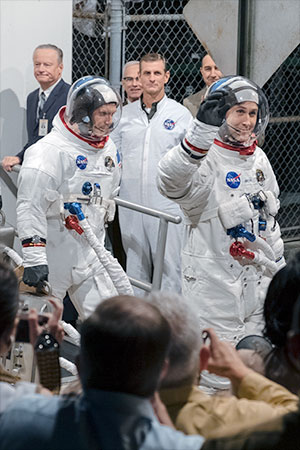
The Apollo 11 crew launch walkout scene from "First Man" includes multiple cameos and easter eggs. (Universal Pictures)
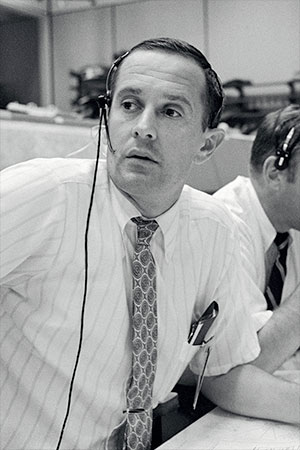
Astronaut Charlie Duke seen as capsule communicator (CapCom) during the Apollo 11 mission in July 1969. (NASA)
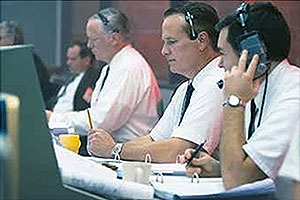
Neil Armstrong's sons Rick and Mark, as well Mark's son Andrew, have cameos in Gemini Mission Control in "First Man." (Universal Pictures via Titan Books' "First Man: The Annotated Screenplay")
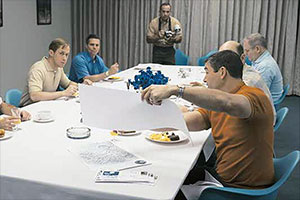
Artist Chris Calle portrays his late father, artist Paul Calle, during the Apollo 11 pre-launch breakfast scene in "First Man." (Universal Pictures via Titan Books' "First Man: The Annotated Screenplay")
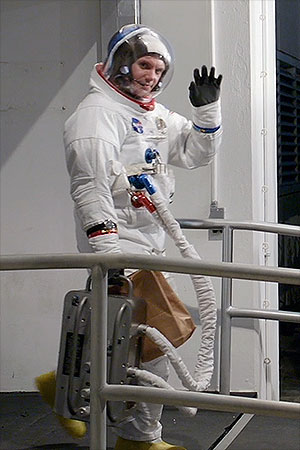
Lukas Haas, who portrays Apollo 11 astronaut Michael Collins in "First Man," made sure he was carrying a brown paper bag during the launch walkout scene. (Universal Pictures)
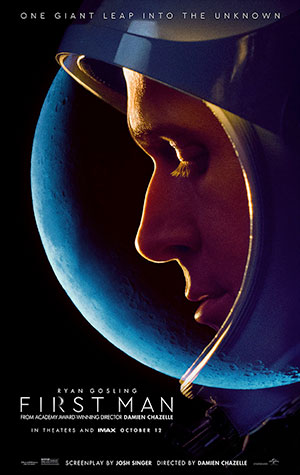
Universal Pictures' "First Man" movie poster. (Universal Pictures) |
